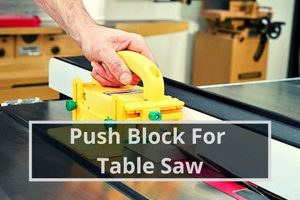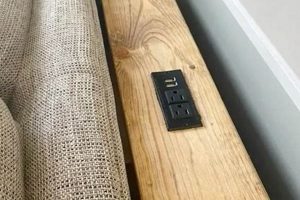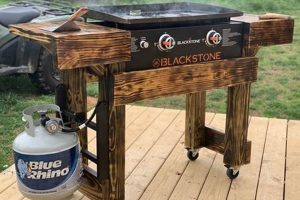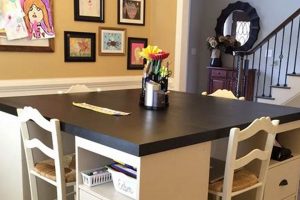A self-assembled puzzle-solving platform offers a customizable and often cost-effective surface for assembling jigsaw puzzles. These constructions can range from simple, flat surfaces supported by legs to more elaborate designs incorporating features such as drawers for sorting pieces, tilting mechanisms for ergonomic use, and covers for protecting works in progress. An example is a basic wooden tabletop supported by folding legs, providing a portable and storable puzzle-solving area.
The creation of a dedicated puzzle area presents several advantages. It provides a fixed location, reducing the risk of accidentally displacing puzzle pieces. It allows for extended assembly periods without disrupting household activities. Furthermore, constructing such a platform can be a rewarding project, fostering creativity and practical skills. Historically, dedicated spaces for hobbies and crafts have been valued for their ability to promote focused engagement and relaxation.
The following sections will delve into the materials selection process, outline various design considerations, and provide step-by-step guidance for constructing a functional and aesthetically pleasing puzzle assembly surface.
Tips for Constructing a Puzzle Assembly Platform
Considerations during the design and build process can significantly impact the functionality and longevity of a self-assembled puzzle workspace. The following tips aim to enhance the construction experience and the overall usability of the finished product.
Tip 1: Material Selection: Choose a sturdy, warp-resistant material for the tabletop surface. Medium-density fiberboard (MDF) offers a smooth, consistent surface ideal for puzzle assembly and accepts paint or felt coverings well. Solid wood provides greater durability but may require more extensive preparation to ensure a flat, even surface.
Tip 2: Surface Treatment: Applying a felt or baize covering to the surface reduces glare and prevents puzzle pieces from sliding excessively. Secure the covering with adhesive, ensuring a smooth, wrinkle-free application. Consider using spray adhesive for even coverage.
Tip 3: Edge Containment: Incorporate a raised edge or border around the perimeter to prevent puzzle pieces from falling off the surface. This can be achieved by attaching thin strips of wood or molding along the edges using glue and brad nails.
Tip 4: Leg Stability: If the design incorporates legs, ensure they are securely attached and adequately braced to prevent wobbling. Folding legs offer convenient storage options, but their locking mechanisms should be reliable and robust.
Tip 5: Sorting Trays Integration: Consider incorporating removable sorting trays or drawers for organizing puzzle pieces by color or shape. These can be constructed from wood, plastic, or repurposed containers and should be sized appropriately to accommodate a sufficient number of pieces.
Tip 6: Ergonomic Considerations: Determine the optimal height for comfortable puzzle assembly. The surface should be at a height that minimizes strain on the back and neck. A tilting mechanism can further enhance ergonomic comfort by allowing the user to adjust the angle of the surface.
Tip 7: Protective Cover: A cover can protect the work in progress from dust, pets, and accidental disturbances. A sheet of plywood or acrylic, sized to fit snugly over the surface, provides effective protection. Hinges can be added to create a convenient lifting mechanism.
By adhering to these guidelines, the resultant construction can provide a functional, enjoyable, and durable space for puzzle enthusiasts. Thoughtful planning and careful execution are essential for a successful outcome.
The subsequent section will address common challenges encountered during the construction process and offer practical solutions for overcoming them.
1. Surface Material
The selection of surface material is paramount in the creation of a functional puzzle assembly platform. The chosen material directly influences the ease of manipulating puzzle pieces, the prevention of damage to delicate puzzle components, and the overall longevity of the constructed surface. A rough or uneven surface can snag or tear pieces, while a slippery surface may lead to uncontrolled movement and difficulty in maintaining the puzzle’s arrangement. Therefore, the selection is a critical determinant of the user experience.
Examples of suitable materials include medium-density fiberboard (MDF), known for its smooth, consistent texture and affordability, and hardwood plywood, valued for its durability and resistance to warping. Conversely, rough-sawn lumber or particleboard without a smooth overlay are generally unsuitable due to their abrasive surfaces and potential for splintering. The application of a felt or baize covering provides an additional layer of protection and grip, further enhancing usability. Failures to consider the surface material’s properties can result in damaged puzzle pieces and an overall frustrating puzzle-solving experience, thereby diminishing the value of the entire self-assembled platform.
Ultimately, careful consideration of surface material properties is crucial to the successful construction of a puzzle assembly platform. The choice directly affects piece manipulation, puzzle integrity, and the platform’s lifespan. Prioritizing a smooth, durable, and appropriately textured surface mitigates potential issues and contributes significantly to a positive puzzle-solving experience.
2. Dimensional Accuracy
Dimensional accuracy, in the context of a self-assembled puzzle-solving platform, refers to the precision with which the components are cut and assembled to achieve the intended overall dimensions. Deviations from the planned measurements can result in a surface that is either too small to accommodate larger puzzles, or possesses uneven edges that allow puzzle pieces to slide off the working area. For instance, if the tabletop is intended to be 36 inches by 48 inches, inaccuracies in cutting the material or assembling the frame can lead to a final product that is significantly smaller or larger, rendering it unsuitable for many standard-sized puzzles. The causal relationship is direct: inaccurate measurements during construction lead to a compromised final product. Therefore, dimensional accuracy is a fundamental component affecting the usability and functionality of the platform.
The practical significance of dimensional accuracy extends beyond simply fitting the puzzle. A precisely dimensioned frame allows for the incorporation of additional features, such as retaining edges or covers, which rely on accurate measurements for proper fit and function. Imagine constructing a cover to protect a partially completed puzzle, but the dimensions of the assembled puzzle table are off by even a quarter of an inch on each side. The cover will either be too tight, potentially damaging the puzzle, or too loose, failing to provide adequate protection from dust and disturbances. Similarly, if drawers or trays are intended to be integrated into the design, accurate internal dimensions are crucial for ensuring that these components fit correctly and operate smoothly.
In summary, dimensional accuracy is paramount in the construction of a functional and aesthetically pleasing puzzle assembly platform. Inaccuracies can lead to a compromised workspace, rendering it unsuitable for its intended purpose and hindering the puzzle-solving experience. Precise measurements, careful cutting, and meticulous assembly are crucial for achieving a final product that meets the user’s needs and provides a durable, enjoyable surface for puzzle assembly. Overlooking this aspect diminishes the overall value and utility of the self-assembled platform.
3. Structural Integrity
Structural integrity, in the context of a self-assembled puzzle workspace, signifies the platform’s capacity to withstand anticipated loads and stresses without deformation, failure, or collapse. It dictates the platform’s longevity and ability to provide a stable, reliable surface for puzzle assembly. A lack of structural integrity can manifest in several ways: a tabletop that sags under the weight of a large puzzle, legs that buckle or wobble, or joints that separate under pressure. Consider, for example, a large, complex puzzle composed of thousands of pieces. The cumulative weight of these pieces, combined with the pressure exerted during assembly, places significant stress on the table. A poorly constructed table, lacking adequate support or utilizing weak materials, will likely exhibit signs of instability, ultimately compromising the puzzle-solving experience and potentially damaging the puzzle itself. Therefore, structural integrity is a critical attribute directly influencing the utility and lifespan of the platform.
The consequences of neglecting structural integrity during construction extend beyond mere inconvenience. A collapsing puzzle table can result in the scattering of puzzle pieces, potentially leading to loss or damage, and requiring significant time and effort to reassemble. Furthermore, a structurally unsound table poses a safety hazard, particularly if it collapses unexpectedly, potentially causing injury to the user. Practical examples include using undersized lumber for the frame, failing to properly secure joints with adequate fasteners and adhesives, or neglecting to brace the legs to prevent lateral movement. All of these oversights can lead to structural weaknesses that compromise the platform’s overall stability. Choosing appropriate materials and construction techniques is, therefore, paramount in ensuring structural soundness.
In summary, structural integrity is an indispensable characteristic of a self-assembled puzzle-solving platform. Its absence compromises the platform’s stability, potentially damaging the puzzle, posing a safety hazard, and diminishing the overall puzzle-solving experience. Employing robust materials, sound construction techniques, and careful attention to joint stability are crucial for achieving a durable and reliable platform. While design aesthetics and functional features are important considerations, they should not come at the expense of structural integrity, as it forms the foundation upon which the platform’s utility is built.
4. Ergonomic Height
Ergonomic height, in the context of a self-assembled puzzle platform, refers to the vertical distance from the floor to the work surface that promotes optimal posture and minimizes physical strain during extended puzzle assembly sessions. An improperly designed height leads to musculoskeletal discomfort, particularly in the back, neck, and shoulders. For instance, a surface that is too low forces the user to hunch over, increasing pressure on the lumbar spine. Conversely, a surface that is too high requires the user to raise their shoulders, leading to neck and shoulder tension. The construction of a customized puzzle assembly surface allows for tailoring the height to the individual user’s dimensions, thereby mitigating these risks. Therefore, proper height is a fundamental component affecting the long-term comfort and well-being of the user.
The practical significance of considering ergonomic height extends beyond the prevention of immediate discomfort. Sustained poor posture can contribute to chronic pain conditions, reduced productivity, and decreased enjoyment of the hobby. The ideal height is generally determined by allowing the user to maintain a neutral spine, with elbows bent at approximately 90 degrees while working. This can be achieved through adjustable legs or a fixed height designed to accommodate the user’s typical seating arrangement. Practical examples include integrating adjustable-height legs purchased from a hardware supplier, or constructing a base with precisely measured dimensions to achieve the desired ergonomic outcome. The absence of attention to ergonomic principles represents a critical oversight in the construction process.
In summary, ergonomic height is a critical consideration in the design and construction of a self-assembled puzzle platform. Failure to address this aspect can lead to physical discomfort, chronic pain, and a diminished puzzle-solving experience. By prioritizing proper height, tailored to the individual user, the constructed platform promotes optimal posture, minimizes strain, and enhances long-term comfort and enjoyment. Recognizing and implementing ergonomic principles is, therefore, an essential element in creating a functional and health-conscious puzzle assembly surface.
5. Storage Integration
The incorporation of storage solutions within a self-assembled puzzle-solving platform represents a significant enhancement to its functionality and user experience. Purposeful integration provides organized space for puzzle piece management, optimizing the assembly process and safeguarding components during periods of inactivity.
- Integrated Drawers for Sorting
Drawers, seamlessly incorporated beneath the tabletop, offer partitioned spaces for sorting puzzle pieces by color, shape, or border versus interior pieces. This organization expedites the assembly process and minimizes visual clutter. Examples include shallow, wide drawers with felt lining to protect pieces and prevent shifting. The presence of such drawers reduces the time spent searching for specific pieces and promotes a more focused work environment.
- Removable Trays for Categorization
Removable trays, often constructed from plastic or wood, provide flexibility in categorizing pieces and can be easily repositioned around the work surface as needed. These trays can be stacked for compact storage or individually transported for focused assembly of specific puzzle sections. Consider clear acrylic trays for easy visibility of contents. Their modularity facilitates efficient piece management and allows for customized organization schemes.
- Under-Table Shelving for Puzzle Boxes
Shelving located beneath the main tabletop provides a dedicated space for storing puzzle boxes, instructions, and reference images. This keeps essential materials readily accessible while minimizing clutter on the work surface. A practical implementation includes adjustable shelving to accommodate boxes of varying sizes. Easy access to reference materials streamlines the puzzle-solving process and minimizes interruptions.
- Tilting and Storage Combination Design
This advanced design integrates tilting functionality for ergonomic access, coupled with a concealed compartment beneath the tilting surface. This hidden space provides secure storage for puzzle pieces and partially completed sections, protecting them from dust and accidental displacement. The concealed compartment maintains a clean aesthetic and prevents visual distractions when the surface is not in use.
Strategic incorporation of these storage elements enhances the utility of a self-assembled puzzle platform. Integrated storage solutions contribute to a more organized, efficient, and enjoyable puzzle-solving experience, maximizing the value of the constructed surface.
Frequently Asked Questions
The following questions and answers address common inquiries regarding the design, construction, and utilization of a self-assembled puzzle workspace.
Question 1: What is the optimal material for the tabletop surface of a puzzle assembly platform?
Medium-density fiberboard (MDF) is frequently recommended due to its smooth, consistent surface, affordability, and ease of finishing. Hardwood plywood offers greater durability but requires more preparation to ensure flatness. Solid wood can be utilized, but its tendency to warp should be carefully considered. The surface should be free of imperfections to prevent damage to puzzle pieces.
Question 2: How does one ensure the legs of a puzzle platform are stable and secure?
Legs should be constructed from robust materials and securely attached to the tabletop using appropriate fasteners. Bracing, particularly for folding legs, is essential to prevent wobbling. Weight distribution should be considered to ensure stability under load. The locking mechanisms of folding legs should be reliable and tested for strength.
Question 3: What is the recommended height for an ergonomic puzzle assembly surface?
The optimal height is determined by maintaining a neutral spine and allowing the user’s elbows to bend at approximately 90 degrees while working. This height will vary depending on the user’s stature and seating arrangement. Adjustable legs or a custom-built base can accommodate individual ergonomic needs.
Question 4: How can one protect a partially completed puzzle from dust and accidental disturbances?
A protective cover, constructed from plywood, acrylic, or a similar rigid material, can effectively shield the puzzle. The cover should fit snugly over the surface and may incorporate hinges for easy access. Sealing the edges of the cover prevents dust infiltration.
Question 5: What are some effective methods for integrating storage into a puzzle assembly platform?
Drawers, removable trays, and under-table shelving are common storage solutions. Drawers can be partitioned for sorting puzzle pieces, while trays provide flexible categorization. Shelving offers a dedicated space for storing puzzle boxes and reference materials. Storage should be designed to minimize clutter and maximize organizational efficiency.
Question 6: How can one prevent puzzle pieces from sliding excessively on the tabletop surface?
Applying a felt or baize covering to the surface provides increased friction and prevents pieces from sliding uncontrollably. The covering should be securely adhered to the surface, ensuring a smooth, wrinkle-free application. Alternatively, specialized puzzle mats or boards with textured surfaces can be used.
These responses offer a foundational understanding of key considerations in the construction of a functional and user-friendly self-assembled puzzle assembly platform.
The subsequent section will explore advanced design concepts and customization options for experienced constructors.
Conclusion
The preceding discussion has detailed critical aspects of self-assembled puzzle-solving platforms. Surface material selection, dimensional accuracy, structural integrity, ergonomic height, and storage integration each contribute significantly to the functionality and user experience. Adherence to these principles yields a durable, efficient, and enjoyable workspace.
Careful planning and precise execution are paramount in the construction of a suitable “diy puzzle table”. Diligence in these areas will ensure a platform that provides years of puzzle-solving satisfaction. Further exploration of advanced designs and customization options can tailor the platform to meet individual needs and preferences.







